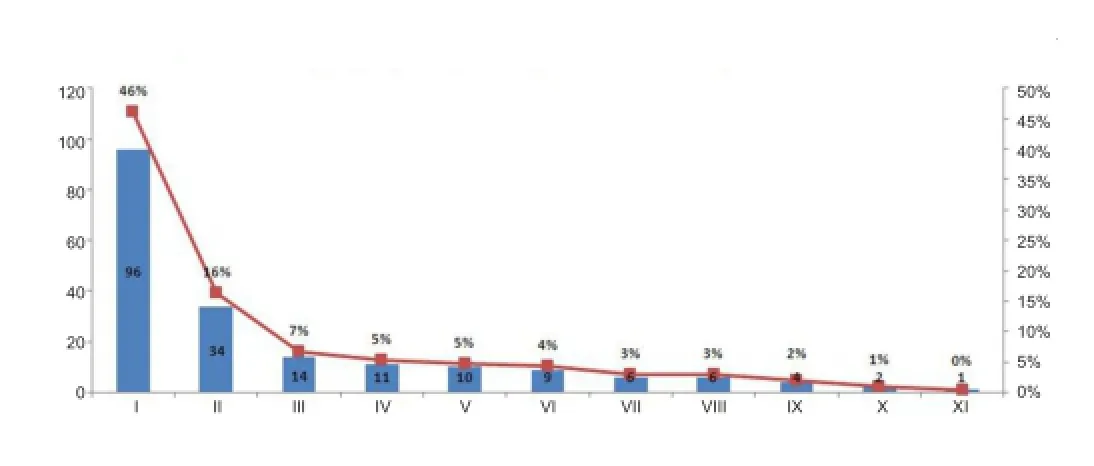Letter from the Editors-in-Chief
2016-12-01Kwok-faiSo,Xiao-mingXu
EDITORIAL
Letter from the Editors-in-Chief
Dear readers of Neural Regeneration Research:
Since the journal first launched in April 2006, Neural Regeneration Research (NRR) has come a long way. First, we would like to thank those who have served on the journal staff and its editorial board over the past 10 years, and particularly the reviewers who have provided the support and feedback necessary to enhance the scientific quality and ensure the integrity of articles.
Highlights/Perspectives/Review Articles Published in 2015
In 2015, over 50% of NRR articles were highlights/perspectives/review articles, which were exceptionally interesting or which offered important comments and clarifications on their original research papers or other peer-reviewed papers published in prestigious journals in the field of neural regeneration. These contributions do not normally exceed 2-3 printed pages, and have no more than 2,000 words. They are solicited only by the commissioning editor within approximately 2 months after an original paper is published, ensuring that the publication remains timely. All highlights/perspectives/ review articles are peer reviewed.
Format of Highlights/Perspectives
Highlights/Perspectives appear at the top of the Table of Contents, providing excellent visibility in an issue.They begin with a fully referenced paragraph, ideally of about 200-300 words, with a basic introduction to the field that is followed by a statement of the main conclusions, and by 2-3 sentences putting the main findings into general context to summarize how the results described in the paper have moved the field forward. The rest of the text is typically about 1,500 words that present outstanding findings, unique models, or novel techniques. A discussion at the end of the text is succinct, does not repeat previous summary/introduction material, and briefly describes the hypothesis and future direction.
More formatting guidelines are available online at http://www. nrronline.org/.
About International Neural Regeneration Symposium Organized by NRR
To promote international scientific exchange and collaboration on neural regeneration research, NRR has successfully organized an International Neural Regeneration Symposium (INRS) in 3 different cities of China between 2011 and 2015. Over 3,000 participants from 115 research institutions of 16 countries have attended these symposia, and over 150 world-distinguished scientists have presented their leading research.
This year, The Joint Symposium of INRS 2016 and the 10thAsia Pacific Symposium on Neural Regeneration will convene in Yinchuan, China during July 29-31, 2016. Please visit the symposium website (http://www.inrs-nrr.org/) for a detailed program. The goal of these meetings is to integrate information about clinical, translational, and basic science related to neural regeneration. To achieve this goal, plenary sessions, mini-symposia, and poster sessions are being planned to focus on topics such as Advances in Stem Cell Research, Innovative Ideas, and Technologies Crossing Disciplines, etc. Plenty of networking opportunities will round out the program. Please join us in Yinchuan for what promises to be an excellent meeting in a historical and innovative city.
NRR’s New Strategies in 2016
1. Get credit for peer review on Publons.com
To recognize your valuable review work, NRR will reward each reviewer with 1 credit on Publons. NRR encourages you to share your evaluations of our published article on Publons. Your post-publication review will not only get you a credit, but also may be published in NRR later. Currently, there are 52,753 reviewers already using Publons, with 268,103 reviews in 15,701 journals.

Figure 1 Highlights/Perspectives/Review Articles published in 2015.
2. Get more citations for your research on Figshare.com
After your paper is accepted for publication in NRR, we will make your work more discoverable, sharable, and citable by uploading your data available on Figshare. This will help you to get extra citations for your work and rank highly on Google searches. Currently, Figshare is collaborating with all open accessed publishers, such as PLOS, Wiley, Singer Nature, F1000 Research, etc.
3. Provide ORCID on authors’ list
Since 2015, NRR has added an ORCID (Open Researcher and Contributor ID) link on all published pdf files to help authors with their publication. This feature will provide each researcher with a constantly updated ‘digital curriculum vitae’ in today’s e-Science world.
By the end of 2015, ORCID had over 300 member organizations and over 1.8 million registrants. In an open letter dated 1 January 2016, eight publishers, including the Royal Society, the American Geophysical Union, Hindawi, the Institute of Electrical and Electronics Engineers, PLOS, and Science, committed to requiring all authors in their journals to have an ORCID ID.
4. Create interest groups in LinkedIn
To take advantage of social media in 2016, NRR will start discussions with our established editorial board members, reviewers, and authors using a LinkedIn Group. LinkedIn is the social network for 277 million professional members. Because NRR is recognized as a publisher, the LinkedIn audience will already trust the group as an established, respected resource.
The editors will start discussion questions among the groups to highlight significant advances in neural regeneration and innovative experimental techniques, and will ask the active group members to serve as administrators who will answer many of the technical questions and guide newer scientists in the right direction. If an interesting discussion emerges in the Group, we will promote the discussion among different forums, such as email or a Letter published in the journal.
In the ever growing and ever changing digital world, we wish to provide you better publishing services to make NRR a success. We welcome your submissions, as well as feedback as authors, readers, and reviewers of the journal.
Sincerely, Editors-in-chief of NRR Kwok-fai So and Xiao-ming Xu
How to cite this article: So KF, Xu XM (2016) Letter from the Editors-in-Chief. Neural Regen Res 11(1)∶5.

10.4103/1673-5374.175037 http∶//www.nrronline.org/
杂志排行
中国神经再生研究(英文版)的其它文章
- Glucocorticoids and nervous system plasticity
- Vascular endothelial growth factor: an attractive target in the treatment of hypoxic/ischemic brain injury
- SCYL pseudokinases in neuronal function and survival
- Direct reprogramming of somatic cells into neural stem cells or neurons for neurological disorders
- RhoA/Rho kinase in spinal cord injury
- Magnetic resonance imaging and cell-based neurorestorative therapy after brain injury
